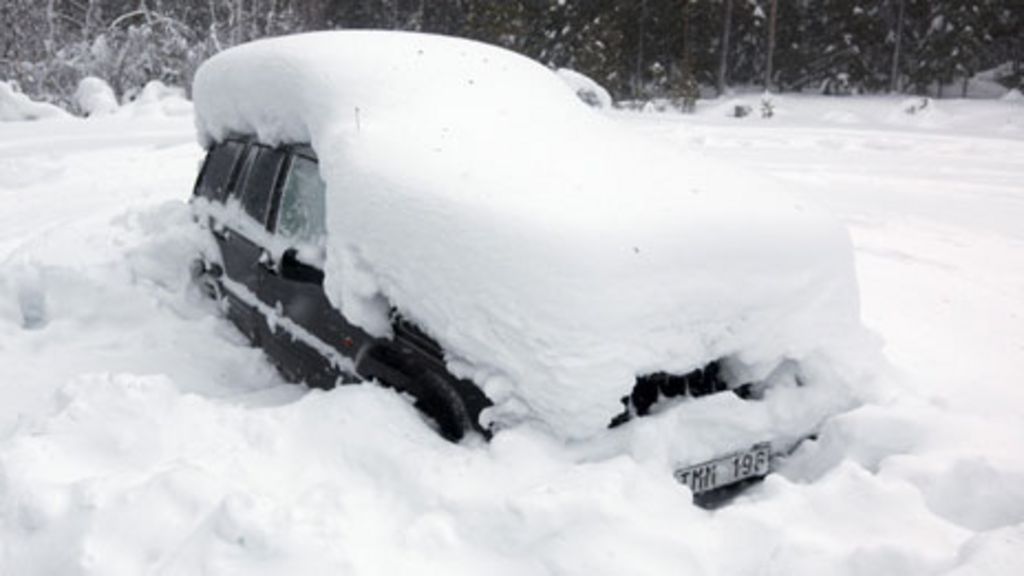A Swedish man, found in a car buried under snow, says he survived for two months without food by eating handfuls of snow. But how long can people go without food?
The circumstances surrounding Peter Skyllberg's survival are still being investigated. However, photographs taken of the inside of the car show empty food and drink wrappers, which could mean the 44-year-old had some sustenance.
The car was found on Friday at the end of a forest track more than 1km (0.6 miles) from a main road in northern Sweden. Police say the temperature in the area had recently dropped to -30C (-22F).
Skyllberg says he had been inside the car since 19 December 2011.
Experts believe it is possible for the human body to survive without food for up to two months.
It's not the first example of humans subsisting on next to nothing for long periods of time.
Japanese hiker Mitsutaka Uchikoshi survived 24 days in 2006 without food and water after he went missing during a climbing trip in western Japan. He was found with a body temperature of 22C (71F) - nearly 15C below normal. After being treated for severe hypothermia and other health complications Uchikoshi returned home, leaving some doctors puzzling over his miraculous recovery.
Last year, a 56-year-old woman from British Columbia survived nearly 50 days in the Nevada wilderness on trail mix, sweets and stream water after being stranded in the mountains while her husband went in search of help. Hunters found Rita Chretien conscious and able to speak, although she had lost 20-30lb as a result of the ordeal.
The American illusionist David Blaine spent 44 days in 2003 suspended in a glass box by the River Thames in London without food. In the 1940s, Mahatma Gandhi survived 21 days on sips of water during a display of civil disobedience.
But even in the chronicles of food and water deprivation, Skyllberg's recent 60-day stint is an extreme case.
"It is at the bounds of possibility but not completely untenable," said Dr Mike Stroud, senior lecturer of Medicine and Nutrition at Southampton University.
Stroud, who accompanied veteran British adventurer Sir Ranulph Fiennes across the Antarctic, said it was possible to survive 60 days without food.
"That is about the time hunger strikers in prisons tend to die," said Stroud. "But they are normally in warmer conditions." In 1981, Republican prisoner Bobby Sands died in Northern Ireland's Maze prison after a hunger strike lasting 66 days.
There are a number of factors that can influence a person's ability to survive, says Stroud, such as the way in which the body's metabolism slows down to conserve energy.
"The average resting human body, doing absolutely nothing, produces about 100 watts of body heat, which could function a light bulb," he says. "But under these circumstances the body will begin to make less and less heat to keep you warm. That's where a heavier body would have more of an advantage."
Stroud also says the amount of body fat a person has at the beginning of the ordeal may not count as much as one might imagine.
"The body needs more than just calories - it will start to shut down its organs one by one. But it could still take up to 60 days for that to happen."
Catherine Collins, spokeswoman for the British Dietetics Association explains that "the body can remodel during starvation to minimise the amount of calories it needs".
When the body stops getting food, it has to live on the stored sugars. The liver and muscles store glucose - the primary fuel source - as glycogen. This glycogen can then be converted into glucose.
When this runs out, fat is then converted into a secondary energy supply called ketone bodies. After the fat runs out, she says, the body must take recycled protein from the system and eventually from the muscles to convert to energy. But this, she says, is "very expensive" fuel for the body because "it's wasting important tissue reserves".
"It's like being in a cold house and burning Chippendale furniture instead of firewood," she says.
However, the resulting muscle loss slows the body's furnace, causing it to burn calories at a slower rate. "So whatever calorie supply you have will last you longer," she says.
"In a way you're trying to eke out what you've got left to help you survive."
Being confined to a small space would have helped Skyllberg conserve precious calories, says Collins, and the isolation of being stuck in the snow alone also would have protected his weakened immune system from potentially deadly infections.
The car was covered in snow, creating what some experts have described as an "igloo effect" on the vehicle.
Dr Ulf Segerberg, chief medical officer at Norrlands University Hospital in Sweden, was quoted in newspaper reports as saying that the insulating properties of the snow may have helped with the man's survival.
A person's mental state can play a critical role in how long they survive, according to Stephen Joseph, a professor of psychology, health and social care at the University of Nottingham.
"People can go into flight or fight mode, and will have adrenalin coursing through them. Those adrenalin surges are important because they will determine how people survive," he says.
And not everyone responds to life-threatening scenarios in the same way.
"In disastrous situations, survival depends on personalities. Some might catastrophise and lose hope, while others are more hopeful and more resourceful," says Joseph.
"Hope is probably a big key to this."
Reporting by Lauren Everitt and Chi Chi Izundu.
